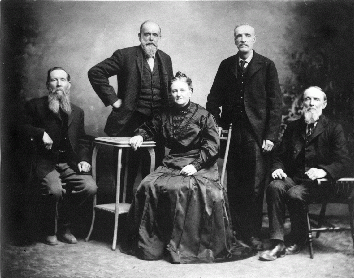

Ann Owen was born April 3, 1809, in Shinefield, Berkshire, England, to Charles Owen and Ann Baker. Her mother died when she was seven and her father when she was ten. Ann became a maid to a well-off lady and her daughter, and worked for them for seven years. During that time she traveled with the family and saw much of England and France. Ann married William Hobbs (b. 1807) in Cheltenham, Gloucestershire, on March 6, 1832. Apparently William had no opportunity for education, as he signed the marriage register with an X. Ann was able to write her name. William ran a “beer store,” which might mean a little grog shop or tavern. Ann and William had five boys: Charles William (12 Feb 1833), Henry (24 Sep 1835), William (16 Mar 1837), James Thomas (19 Nov 1840), and Thomas (28 May 1843); followed by twin girls: Caroline (Kittie) and Mary Ann (28 Jun 1846), the younger of the two. All were born in Cheltenham. William Sr. died of pneumonia September 2, 1846, at the age of 38, just three months after the twins were born. Ann, who didn’t want her children to grow up in a beer shop, sold it and went to work as a seamstress to feed the family. Her son Charles became a clerk while still a teen to help support them, and at least some of the other children worked as well when they were old enough. Kittie worked as a servant for a rich family.
Thomas, the youngest son, fell from bed and injured his back. Ann fainted when the doctor told her he would be hump-backed, but in fact Thomas got worse and died on April 24, 1852, a month shy of nine years old. In 1851 Charles and William went to a Mormon meeting, according to Kittie, “with the intention of making fun of the elders, but when they heard the preaching they became very interested, and came home and persuaded mother to go to the next meeting. Mother went and was converted as soon as she heard it.” Eventually the whole family joined the Church. Charles was first to be baptized, on April 15, 1851, at age 18. Henry followed on May 26 (age 15), William on July 28 (age 14), Ann herself on August 26 (age 41), and James September 24 (age 10). The twins were baptized August 23, 1854, a little while after they turned eight.
Not long after Ann’s baptism she developed a felon (a type of infection) on her thimble finger. It got so bad that for three months she could not sew to provide for her family. Kittie writes: “The visiting priests would come around and they would tell her if she would leave that horrible religion they would clothe and care for her children. She told them she would not as she knew it was true.” The first bone of the finger finally fell out, after which she recovered.
In 1856–57 Elders Ezra T. Benson and Orson Pratt were presiding over the British Mission. Kittie says: “Apostle Benson . . . came to mother and asked her if she would let her two boys go on a mission and he would see that she was sent to the Valley. Mother let them go and they went to the magistrate to get a license to preach and he laughed because they were so young. One was only 16. I think Henry was gone two years and rose up a branch of the Church and was put in as president. But he suffered many hardships. The other boy went and worked for a man.” The younger brother who applied for the license may have been William, actually 19. His history says that in 1856 he was made a teacher and spent a year helping the missionaries “distribute tracts, hold meetings, etc.”
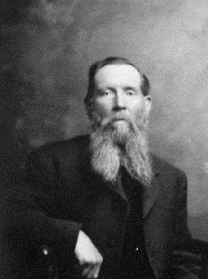 |
| Henry Hobbs |
We don’t know quite when Henry started his mission, but according to the Millennial Star, he was made conference president in Hull, Yorkshire, in January 1857. Henry figures in the journal of a missionary companion, Seymour B. Young Sr., one of a set of 70 missionaries from Utah who crossed the plains by handcart going east in 1857. Henry, Seymour, and the other missionaries worked without purse or scrip, meaning they depended on the local people for their support. Seymour’s journal describes them traveling by “cars” (trains) as well as packets (inexpensive steamers) but most often on foot. They preached in the markets, sold literature door to door, called on members or sometimes strangers at mealtime and bedtime. They also provided meetings and ordinances for the members on Sundays and fast days. On August 18, 1857, Henry and Seymour preached in the market in Thoresby. When no one offered to give them a bed, they asked for one at the local inn. The woman was willing, but her husband overruled when he learned they were Mormons. They walked to another village, where the innkeeper also refused them, and by now it was too late to ask anyone else. “So we went into a field of wheat,” Seymour writes, “and put our carpet bags down for a pillow and pulled some sheaves of wheat over us and committed ourselves to the care of our Heavenly Father.” It was too cold to sleep very well. The next day they walked to Grimsby and preached to a large crowd in the street. “We had good order [but] when we had done speaking some of the people said, ‘Put them under the pump,’ but some of them objected, and so they followed us down the street and threw stones at us, but God be praised, we were not injured” (58–61). Seymour describes this kind of scene several times.
The Millennial Star notes that in January 1858 Henry was made conference president in Carlisle, near the Scottish border. He served here 15 months. Here he operated a reading room and no doubt also continued to travel and preach in the countryside. We have Henry’s own journal for 1859, which covers the tail end of his mission. He mentions a lecture he gave in the reading room on the history of Israel, and also a pair of articles he wrote for the Star. In the first he speaks of the importance of “cleanliness, both in person and habitation. . . . If some . . . people could have a peep into the eternal mansions of the faithful, and see the beautiful white garments they wear and the purity of their persons, and then look at themselves and their habitations, it would surely be enough to . . . cause them to repent of their sin of uncleanness.” In the second he writes of the importance of literacy and encourages those who cannot read well to improve their skills. “Let us not despair, but put our shoulders to the wheel; and, through the blessing of God and our own exertions, we can overcome every obstacle and be prepared for celestial society here and hereafter.”
On March 29, 1859, Henry “packed up my things [and] assembled at night with the Saints for the last time, sung some songs and recited some pieces of poetry and left them in good spirits.” He took a packet boat to Liverpool (he did not return to Cheltenham). On the way he “preached to the passengers and sung them ‘O Ye Mountains High,’ which they very much approved of.” His journal describes preparations for his marriage to Miss Jane Bellman, whom he must have met on his mission. Jane was born June 16, 1823 in Overston, Lancashire, a daughter of James and Jane Bellman. Henry and James were married April 4, 1859, at a Church of England chapel in Liverpool. A few days later the two of them, together with Henry’s brother William, boarded the William Tapscott in Liverpool and began their journey to Zion.
Henry describes the rations on the ship, the more or less ongoing seasickness, and general life aboard. The members held meetings often. Of one he writes: “I was called upon to speak and said I rejoiced in the plan of organization, that it was good and would save the people.” The ship’s 700 plus Saints, from all over Northern and Western Europe, were grouped in 10 wards. “I referred to the different ships that left for foreign lands and the great amount of young women seduced on them and said I considered we were highly favored to have such good rules to prevent sailors from abusing our women.” The Mormons had their own police force, partly to stop petty theft (potatoes taken from ovens, etc.), but mostly to keep the sailors from bothering the female members. “I said [the gospel] was like a wedding ring, but one eternal round, and that it would roll forth and fill the whole earth with light. I said I considered it was the greatest testimony we could bear to the nations to emigrate.” In another meeting, one of the elders preached against hasty courtships and said he refused to marry any couple who met on board. Then he proceeded to marry 14 couples from three different countries. At a third meeting in the bachelors’ hall, a brother used a metaphor similar to Henry’s regarding a young courting couple: “The young man said his love was like a wedding ring, it had no end. She in reply said that her love was like the wedding ring, for it never had a beginning.” Just as frequent as meetings in Henry’s account were the dances and concerts, with “lots of comic and sentimental songs.” Once the Saints organized a lyceum (debating match): “Subject: whether was the most beneficial to the masses of the people—the compass or the press.” Another time the brethren amused the members on deck by preaching in the styles of different religions.
They landed in New York and traveled by ferry and on the newly-completed railroad to St. Joseph, Missouri. Henry comments on slaves and the slave market there. Henry, Jane, and William fitted out with the George Rowley pioneer company, which was the eighth handcart company, the only company to go by cart that year and the first since the Utah War. The company consisted of 235 souls, 56 carts, and 6 ox-drawn wagons. Henry was appointed a captain of 10. While they waited for their carts in Florence, a boy named Frank Pitman would sing the handcart song for anyone who asked him. The Saints loved to hear it because it was new to them. Fewer asked him to sing it after their first hard day of walking and pushing and pulling, and at the end of the second, when someone did asked, he stomped his feet and yelled, “I will never sing it again!”
Henry’s journal gives a good sense of life on the trail. On July 1 he writes: “Traveling today we came across the best part of a buffalo killed by the Pikes Peakers the day before.” Pikes Peakers were those traveling to and from the gold fields in Colorado. The meat had a note attached that said: “This is for the handcarts.” Henry noted: “Some portions of it stunk, being exposed to the sun, but many got a good supper out of it. I enjoyed mine well.” On July 3, he says, they
“met with a band of Indians who were well armed and plenty of horses. They were called Sues [Sioux] and were expecting the Pawnees to battle with them. They were quite friendly and shook hands with us and went and killed a buffalo for us and brought the meat several miles on their horses and distributed it among the people. . . . Had an excellent testimony meeting in the evening. Some good testimonies were borne and the Saints rejoiced. Two of the Indians was at meeting. In the night four of the Indians came in to our camp and danced and yelled and made a fearful noise. Some of the brethren and sisters were most terribly scared and thought the Indians were upon them. Others were calm and serene: this was only a little of their frolic. They would have liked to have taken two or three of our sisters for wives. One of them took a sister’s portrait on a tin cup. It was taken in the same style as the hieroglyphics in the Pearl of Great Price.”
The next morning, he notes, “the Indians were loath to leave us and followed us some distance on their horses and gave some of the Saints the ropes round their horses’ necks and helped to draw the carts.” He mentions other times the Indians helped them, but also times they demanded presents, pilfered biscuits, stampeded cattle, and stole a pony. At Devil’s Gate some Indians came into camp fresh from a war party, holding new scalps up on sticks. They invited some of the pioneer men to their camp to see them torture and kill their prisoners, but the pioneers said no. The Indians were not the only ones on the prairie looking for wives. On the night of July 6, “two men came back from the Pikes Peak camp, which was eight miles ahead of us, and told us they wanted two of our girls. Of course they had their journey for nothing.” On August 15 an Indian brought in a sister who had strayed from camp and been without food for two days.
They met more than one train of apostates going east. Some he notes were civil, but of others he writes: “They were filled with an evil spirit and looked devilish. One of the nincompoops said some things about whipping our captain. It was a good job for him that he closed up his mouth or he would have got what Paddy gave the drum after dinner.” Some of the pioneers got discouraged and went back with the apostates. Henry writes of hard pulling through mud, dust to his knees, steep hills and banks, sand, sand, and more sand, also early mornings, late evenings, guard duty, broken carts, days without water, and “muskitors” (mosquitoes) that sometimes “tickled” them at night to where they couldn’t open their eyes in the morning. People grumbled and began to accuse the teamsters in the baggage wagons of raiding the stores and the captain of having a pound of bacon with each meal. This kind of talk could be disastrous on the plains. The captain stopped the train for a meeting and rebuked them and had each captain of ten do the same. Henry, who throughout his journal comes across as cheerful and inclined to see the good, takes a softer approach than the others:
“I . . . said that I had heard none of this grumbling in my company and if there was, it was behind my back. I referred to the time we were on the bosom of the great deep and to the excellent character given us by [the] captain and President Neslen, and then asked if they could now give us such a character. I said I hoped we would put away from us everything contrary to truth and righteousness, murmuring and everything else, and then we would go on our way rejoicing and would still have our good character when we got to Zion, etc. I also spoke of the many disembodied spirits that followed our camp and how liable we were to be overcome if we were not humble and on the watchtower. Many of the brethren confessed their faults and asked for forgiveness and promised to do better. All were forgiven by the unanimous voice of the people.”
On July 22, when the company got to Chimney Rock, they realized they were running out of food. They divvied out the last of the flour at Devil’s Gate on August 12. Henry had a dream they would be resupplied that side of Fort Bridger. A man from Salt Lake met them on the Sweetwater. He was heading east to find his sweetheart. He found her in the camp, and they were married on the spot. On August 31 a Brother Shanks died. Henry writes:
“He was nearly 70 years of age and had completely worn himself out pulling his cart. I helped to get pebbles to lay on him to prevent the wolves eating him up. This morning intelligence was brought to the camp that Sister Shanks had been eat by the wolves. She also pulled to the last, to the shame of the young sisters who rode in their place. They were good Saints.”
Henry realized he and Jane had given the old couple their last meal together. Another time a guard came upon the rotting carcass of an animal with a large predator eating it. He raised his gun to shoot, only to realize it was not a predator but a half-starved pioneer from his own company. Henry writes, “I think a one horse trap should be sent with the handcart company to fetch up the sick and not leave them to the care of strangers.” This is about as close as he ever comes in the journal to complaining. As supplies dwindled, more pioneers turned back, and others begged food from apostates. Some hairy traders at Big Sandy fed the starving company a meal. They said they wanted to get wives and offered to marry any or all of the women. To the pioneers’ surprise, two of their women accepted the offer. They had a wedding ceremony, and the women stayed behind.
Word reached the relief wagons from Salt Lake City that the handcart pioneers were starving. They traveled night and day with their mule teams and reached them on Hams Fork on August 24. Henry writes, “These were truly welcome and blessed visitors. Here my dream which I had at Devil’s Gate was fulfilled.” At Fort Bridger he notes, “the soldiers stared to see us so jovial while pulling our carts.” Apostles Ezra T. Benson and Erastus Snow accompanied them the last few days of their journey. “Brother Benson was glad to see me.” They entered the Salt Lake Valley on Sunday, September 4, stopping on the bench near Emigration Canyon for a meeting. Elder Benson warned: “After you get some warm biscuits and butter, don’t turn up your noses as some have done, but continue to live your religion as you have done, and all your expectations shall be realized and a thousand times more.” They were met near the city by “two bands of music.” Henry notes “thousands of spectators” as they passed through the streets of the city—the residents of Salt Lake were just getting out of church in the bowery and came to greet them. The parade “went by Brigham’s. There was a large crowd on top of his house looking at us, Brigham among the rest. I was much delighted with the beautiful appearance of the city.” The bishops helped them find places to stay, but not before giving them a banquet of every good thing: “bread, butter, eggs, milk, coffee, tea, sugar, boiled beef, roast beef, mutton, pork, potatoes, cabbage, carrots, onions, cucumbers, tomatoes, squash, musk melons, watermelons, green peas, kidney beans, and tarts, etc.”
Henry’s journal paints an interesting picture of life in Salt Lake City in pioneer times. Early on he mentions a complimentary bath in the “warm sulpher spring,” doubtless the one where the Children’s Museum of Utah is now. Baths in general (most of them cold) were apparently rare enough to merit a mention in his journal each time. His second day in the valley he landed a position with Hugh Moon. Brother Moon, a faithful member of the Church, early on had gotten Brigham Young’s permission to make a little whiskey, mostly for medicinal purposes, but it grew into a major operation, and as the Church did not then put the same emphasis on the Word of Wisdom, only a portion went for medicine. His distillery supported his large farming operation. Henry worked feeding and cleaning up after Brother Moon’s pigs in exchange for board and a wage, and Jane cooked for him for board. Henry may have had the lowliest job in the community, but the pioneers made no bones about that. He was invited to all the parties, gave talks, gave blessings, sang, and took an active part in the life of the ward. One Sunday he and William had dinner with Elder Ezra T. Benson and then tea with President Joseph Young of the Seventy. Henry remarks that Joseph’s son Seymour, his old missionary companion, “gave me such a feast of peaches!”
The different wards sponsored all sorts of cultural activities. Winter nights Henry attended grammar school, where he “wrote, read, and syphered, and spelt.” He attended public lectures and lyceums as well, in addition to attending a singing school. He notes, “None seems to enjoy themselves like this people.” He records talks by “Brigham,” “Eber” (Heber C. Kimball), and various Apostles most every Sunday. Some preached on plural marriage. In February he went to see a Sister Sarah Yeates about her becoming his second wife, but she said she had another suitor and had promised to marry him the next day. On Christmas day Henry heard gunfire, which he took for simple merriment until one of the balls struck him in the leg without injuring him. Bill Hickman and Lot Huntington had gotten too much of Hugh Moon’s whiskey in the saloon and were shooting at each other. This brought forth some sharp rebukes on Sunday. Hugh Moon eventually came to understand the brethren were not happy with his distillery, so he closed it down, and later accepted a settlement mission to St. George. For now he was a generous employer, paying well enough that he was criticized openly in church for it. Bit by bit Henry outfitted himself at stores in Salt Lake City.
In June 1860 Henry and Jane moved to Wellsville in Cache Valley and received an allotment of land. His journal ends here suddenly, so we know considerably less about him from that time on. He appears on an 1863 list of pioneers in Franklin, Idaho, which was the most remote Mormon settlement at the time. Henry and Jane traveled to the Endowment House in Salt Lake City to be sealed to each other on June 13 of that year. They later worked a dairy farm in Hobbs Hollow, which is now in the east part of Layton, Utah, but then was part of the town of South Weber. We know that Henry was a “home-” or “county missionary” in 1888. His assignment took him to a different community in Davis County every two weeks: Kaysville, Farmington, Centerville, East Bountiful, West Bountiful, South Bountiful, South Hooper, then South Weber again, all in the days before cars. Henry and Jane had just one child. Jane died on February 12, 1910, in Ogden. Henry married Helen Elizabeth Williams two years later on June 19, 1912. He died November 10, 1917, in Salt Lake City.
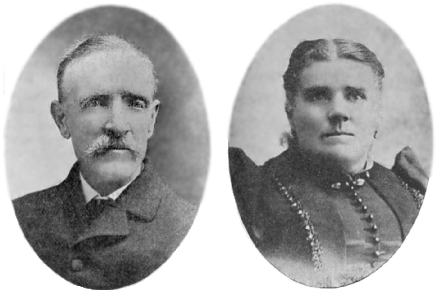 |
| William and Matilda Barrett Hobbs |
While still on the ship to America, Henry wrote: “Sister Matilda Barrett has been a friend indeed to me and my friends in cooking us our food, etc. May she be abundantly blessed is my prayer.” Matilda, then just sixteen, apparently caught the eye of Henry’s brother William as well, because a year later they were married. One detail from their history: When they arrived in Salt Lake and saw the wagonloads of bread brought to the square, their mouths began to water and tears streamed from their eyes. We don’t know all William did at first—Henry records sometimes helping him gather wood, no doubt for sale. Matilda spent her first year in the valley with the family of Bishop John M. Woolley, after which she and William wed on October 3, 1860, in Salt Lake. They were sealed in the Endowment House three years later on June 13, 1863. Matilda was born May 28, 1843, in Pontepool, Monmouthshire, England, to William Barrett and Phoebe Coburn. She and William eventually had eleven children. William worked in Salt Lake hauling wood for the soldiers at Fort Douglas. He served as a bodyguard for Brigham Young in 1862–63. In 1864 he was hauling wood again for the Fort Douglas soldiers. Younger brother James, who worked with him briefly, says they would go up into the cottonwoods in the canyons with wagons: “On the way home generally 3 or 4 teams would be together to assist one another. They had to lock the wheels for about 8 miles down the steep hills with scarcely anything of a road. In some places they would have to get together and hang on to one side of the load to save it tipping over.” James considered this a pretty shabby undertaking and quickly moved on. William’s mother and all his brothers and sisters were in Franklin now, so Henry decided he would come too. “There,” his history says, “he took an active part in defending the settlers from the ravages of the Indians.” In 1865 he moved to Helena, Montana, and spent eight years as a miner, returning in 1873. He and Matilda settled in West Jordan, where he had a business “contracting and shipping slag from the smelter dumps.” William and Matilda’s histories give very few personal details but do say that Matilda proved “a firm Latter-day Saint” and that Henry served faithfully as a ward teacher for many years. Matilda died September 28, 1921, in Midvale. William died October 16, 1922, also in Midvale.
Back in Cheltenham, older brother Charles had married Mary Ann Emms on August 28, 1854. He was 21 and she 19. Mary Ann was born January 22, 1835, in Cheltenham, the second child of Charles Emms, a basketmaker, and Edith Ayers, who worked as a servant. Mary Ann made straw hats as a girl. She joined the Church on April 7, 1853, at age 18, two years after the Hobbses and one year before she married. By 1862, when Charles and Mary Ann left for America, they had four children. They sailed with 700 Saints on the John J. Boyd from Liverpool around the north of Ireland to New York City. The captain and his wife were kind to the Saints, but the third mate and some of the sailors harassed them, crashing into a meeting and singing loudly in opposition, also trying to seduce the women. As with Henry and William’s company, the Saints posted a guard, and the captain soon forbade the mate from going below. In New York it was all the missionaries could do to keep the sharpers (swindlers) away from the emigrants. The Saints took a train to St. Louis, passing Niagara Falls, and saw burning Civil War battlefields in Missouri. The bridges were protected by Union soldiers. The pioneers then took a flatboat to Florence and waited a few weeks until the Church wagon trains arrived.
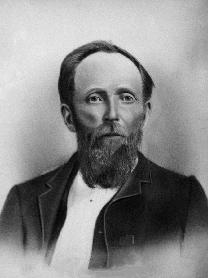 |
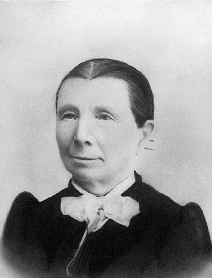 |
| Charles and Mary Ann Emms Hobbs | |
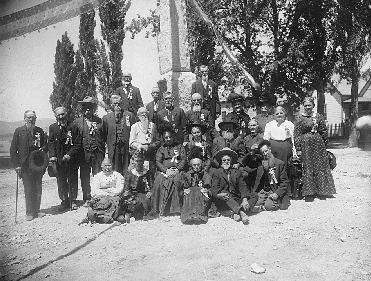 |
| Franklin pioneers in 1911, Charles standing far left |
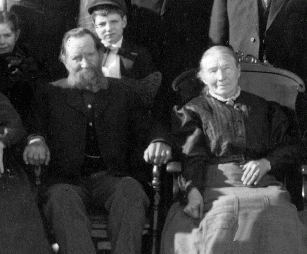 |
| Charles and Mary Ann at Hobbs Reunion, 1911 |
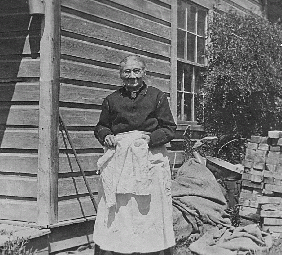 |
| Another picture of Mary Ann |
They went west in Homer Duncan’s company. Twelve people were assigned to each wagon, which carried all their baggage and supplies, so everyone had to walk who could. Mary Ann walked most the way carrying her baby. They pulled the wagons into a circle each night to form a corral. The emigrants and teamsters slept in tents, one per wagon. They had flour, bacon, and beans for rations, and pans and kettles allotted to cook them in. They stopped Saturdays to wash and Sundays to rest if there was grass for the animals. They held a prayer meeting each morning. The oxen stirred up enough dust to make everybody miserable during the hot daytime. In the evening the emigrants told about the old country and the teamsters told about the new. Some had violins, accordions, or concertinas, so they had singing and dancing. Both Charles and Mary Ann were good singers, and all the histories say Mary Ann had a jovial personality and helped keep things lively on the plains. They went straight to Franklin, Idaho.
On arriving, Charles worked on roads and ditches, sometimes single-handed. Later he took up a farm in Cove, Utah. Mary Ann sewed to help support the family. Charles did his share of guard duty to protect the cattle from Indian raids, and the two of them helped care for the soldiers wounded in the Bear River Massacre. Mary Ann cooked for them and Charles delivered their food, and they also kept some of the solders whose feet were frozen. Grasshoppers made it hard to raise enough to eat the first few years. Mary Ann made friends with everyone, including the Indians, and, as little as they had, always gave them something to eat when they came by. Charles and Mary Ann had thirteen children, of which twelve lived to adulthood. They ran a boarding house for many years. With the boarders and all those children, their home was no doubt a noisy place—Mary Ann has such a warm, infectious smile in every picture we have of her that it’s easy to see her as a hostess. According to the histories, the Hobbses “were kind and hospitable, and pleasant to stay with.” Some of their children went into the hotel business too. Charles and Mary Ann were sealed in the Endowment House on November 8, 1867.
Mary Ann and Charles were both industrious and hard working. According to grandson B. R. Parkinson, in 1872, when his father Samuel C. Parkinson asked Charles for the hand of his mother, Polly, in marriage, Charles told him “he could have her if she would repay the $86.00 due the Perpetual Emigration Fund for her transportation to Zion.” The story suggests that Charles struggled under the burden of the debt, but also that he believed in meeting his obligations. Charles and Mary Ann were well-known community singers. They were founding members of the ward choir and served for many years. Charles served also as president of the high priests in Franklin, and we get a few glimpses of him in the minutes: teaching, praying, bearing his testimony. In one meeting in 1903 he urged the brethren to “never give the cold shoulder to those who repent.” In another in 1904 he “said that he enjoyed himself first rate whilst at the [general] conference. On July 10, 1907, at the age of 74, he “said that he felt well in the faith and wished to prove faithful to the end.” He died February 15, 1913, in Franklin. Mary Ann died March 26, 1919, also in Franklin. We get a glimpse of her in a pair of obituaries. One says, “She was kind and free hearted dispositioned and her little grandchildren and others will always remember her for her generous and kind-hearted nature.” Another notes, “‘Grandma’ Hobbs always made friends.”
Once Charles emigrated, of the original family only Ann, James, and the twins Kittie and Mary Ann remained in Cheltenham. They too emigrated to America, in 1864. They crossed the ocean on the Monarch of the Sea with a large group of mostly Danish Saints. A terrible storm arose, and according to Kittie, “the captain said if we had ever prayed before we had better pray now or we would go down. . . . We all asked the Lord to preserve us and the storm passed.” Due to the war they had to ride in cattle cars out of New York City. Kittie states, “I never heard my angel mother complain.” They crossed the plains in John R. Murdock’s company. Indians visited their camp, and like the other companies, they gave them presents. One woman in the camp died, as well as one man, who accidentally shot himself while on guard duty. Henry and William met their mother and siblings in Salt Lake and drove them to Franklin. Kittie remembers: “We had a pig in the wagon as a passenger and it got out and we had trouble enough chasing it through the sage brush before catching it.” They stayed with a friend in Logan. “In the morning as we were about to start I fell in the river near his house, and had to wear my wet clothes to Franklin. At Franklin we stayed with my brother Charles, who had a little two room log cabin without windows or floors.” The fort at Franklin at that time consisted of log shacks with dirt roofs arranged in a square for protection—two rooms for a family was as much as anybody had. “We did our cooking in the fireplace. We were very uncomfortable. I thought if this is Zion I wish I was back in England.” We know practically nothing of Ann beyond this time. The 1870 census has her living in Logan with James, who is listed as a farmer. On October 30, 1871, she went to the Endowment House in Salt Lake and received her endowment. The next day, November 1, she was sealed to her husband William. She died July 25, 1894, in Logan.
James, back in 1864, was one of 11 boys from his ship hired as teamsters by a Mr. Merrick or Murrick for $50 a month in greenbacks. He writes, “As greenbacks were only worth 50 cents on the dollar, it amounted to 25 dollars per month”—not much even for those times. James was assigned two yoke of oxen, one wild and the other poorly broke. He notes that by the time they had them hitched for the first day’s journey, “we were nearly all broke.” James took his turn herding and standing guard at night, armed with his pistol, “a small, single barrel affair given me by one of my old masters in England with a nice long cloak, telling me at the time it would do for me to stand guard on the plains. One of the missionaries that was staying with us at the time in England told me he would stand across the street and let me shoot at him all day with it, so it was not very dangerous.” This is not to say the danger was not real—they kept hearing of Indians attacking and killing parties ahead and behind them. “Through the blessed love of our Heavenly Father, like most all the early experience of the first Mormon settlers, we generally escaped without fighting.”
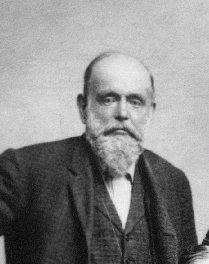 |
| James T. Hobbs |
James writes that Mr. Merrick “was a very course man and a great bragger.” The young teamsters, he notes, were not well-prepared:
“Some of them had worked at needle making. Factory hands was their life’s work in England, and made very poor drivers. In fact, I heard of one putting on the brakes going up hill and taking it off going down. This made the big boss mad and he commenced rising the black marks on a few of them, this was resented. He took the liberty of telling the captains of other gentile trains how he was whipping the Mormon boys. One of the captains told us if we wanted to leave him he would take us through with his train. It got worse and worse until we could stand it no longer. So I got the boys together and said let us quit right here. I was the only one that had a pistol in the bunch. And of course I felt as big a man as the captain with his revolver. When our captain saw our determination, he tired to down us by saying, ‘You will have a hard time of it,’ and many other things. . . . When the captain saw we meant it, he cried like a little babe and said if we would only stay with him we would not hear another oath out of his mouth. And he would get us fresh beef, so we concluded to stay and from then till we got into Salt Lake it was a pleasure trip. But the beef was rather too fresh for some as it caused many to be seasick at the wrong end.”
He mentions storms, also river crossings, which according to other teamsters could quickly turn into white-water adventures. “But we was supplied with some good pure whiskey for refreshments.” Even the Mormon teams in those days thought of whiskey as a way to fight the cold. He mentions also the great feast given the pioneers on their arrival in the valley. “It was the first time we tasted tomatoes and I have no doubt most of my readers will recollect the pleasant taste of the same on first acquaintance.” This is more of James’s humor. Most European immigrants were repulsed by the taste of tomatoes.
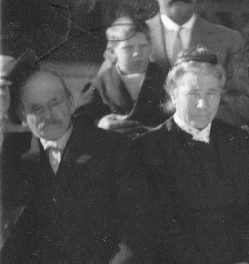 |
| James and Martha Catmull Hobbs |
James, who now had experience with oxen, thought he would like to do like his brother William and haul wood for Camp Douglas, but as noted, when he saw how they were doing it he decided to join his mother and siblings in Franklin instead. “I had only been in Franklin one or two days before Henry’s wife ran for me to get my gun, as there had been one or two Indians and some of the brethern killed.” Washikee and 400 of his people were camped in the Cub River bottoms, and that day when all the pioneer men were out in the fields, some young Indian men came into town and demanded whiskey at the store. “The women being scared had to let them have what they wanted. One of the Indians”—James says this was Washikee’s own son—“got drunk and commenced whipping a woman on the street with a club. One of the brethern coming by at the time took his pistol and shot the Indian.” The Shoshones in the bottoms and throughout the valley were furious and amassed for war. The brother headed south, warning the people in each town as he went—James notes, “I will just state that I never saw the man again after shooting the Indian.” The settlers quickly gathered all the women and children in the old log meetinghouse “with a few of the oldest men with their guns to guard them. The rest of us was placed at the three approaches coming up from the river.” This would have include Charles and Henry too. The Indian women set fire to the hillside, and it burned for miles. A few of the settlers had been running a threshing machine near the Shoshone camp. All escaped but one: “His name was Robert Hull, a Scotsman and a very nice fellow. . . . They took their prisoner into camp, which happened to be just under my crowd, laid him on his back and drew their bow knives and was about to slay him. We could hear his cries for mercy. So Bishop Lorenzo Hatch with an Indian interpreter and one of the others went down to their camp and pled for his life. After pleading for some time with them, Washikee said that he would not of cared so much if they had given the Indian, his son, a clubbin instead of shooting him. Brother Maughan told him he would shoot any Indian that was beating a woman with a club and thought the man justified.” The leaders got the situation diffused, and after a few days most the Indians left, “but there were a few remained and hid in the brush and at night would fire into the settlement trying to get one for the Indian that was shot, which caused us to take turns in standin guard for weeks in snow three or four feet deep and bitter cold.”
James’s history includes other Indian adventures, of going out at twilight, seeing Indians under every clump of sagebrush. James reveals a cautious side again as he speaks of the danger of settlers firing on each other in these situations: “I often thought we was taking desperate chances.” Once the report came that the Bannocks were stealing their cattle. A band of Shoshones were camped on the river. “The chief . . . came into town and said if a white man would go out with him he would take his braves and fight them. He could not get anyone to go. I told one of the brethern if he would let me have his horse I would go with him. ‘All right,’ he said.” James and the chief rode back to the Indian camp, told them what had happened, and then turned and rode toward the cattle. “Before we got to the other bank of Cub River all his braves caught us giving their Indian yells and their hair flying behind them. We was making good time.” A mile down the road they met some pioneers who let them know it was a false alarm, “so we all returned feeling fine.” James says the Indians were more numerous than the whites. “I will say there was always Indians around and they would come and press their faces against our windows while we were eating and plead for food, which was not over plentiful, but we always gave them some, taking the council of President Young that it was better to feed them than fight them.” James helped William and his family move to Franklin, which meant that for a short time all the family was together again. “This was one of the pleasantest winters I ever spent. The snow fell so deep that we could not do very much work except getting wood from the canyons and going to meetings and dancing.”
James’s history ends there. He may be the James Hobbs who taught school for a time in Franklin. As noted, the 1870 census has James farming in Logan and taking care of his mother. He married Deseret (Desie) McCann on August 4, 1873, in the Endowment House, at the age of 32. She was born September 28, 1857, in Ogden, a daughter of Thomas Ravenhill McCann and Sarah Johnston. James and Desie had at least four children but then divorced. She died January 15, 1916, in Garden City, Utah. James married Martha Catmull on December 26, 1878, in the Endowment House. She was born on July 15, 1852 in Gravely, Cambridgeshire, a daughter of John Bradley Catmull and Susan Arbon. Her history notes she sang at the LDS conference in London. James and Martha lived in Logan before moving to Benson in Cache Valley in 1882. They had 10 children. James farmed. Martha sang in the choir and served in the Primary and Relief Society and from 1882 to 1893 ran the Benson post office from their home. We have one more glimpse of James, in 1905 when he visited the Franklin high priests quorum. “Brother James Hobbs of the Benson Ward gave us a little of his history,” the minutes state, “and bore a faithful testimony.” In 1909 James and Martha moved to Logan again. James died there October 29, 1920. Martha ran a boarding house after to support herself but died herself just two and a half years later, on March 6, 1923, also in Logan.
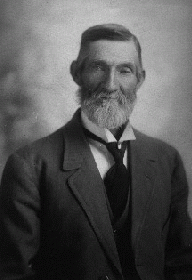 |
 |
| William Watterson Jr. | Kitty Hobbs Watterson |
In 1865, the year after Kittie arrived in Franklin, she moved to Logan, where she worked for the John Smith family. Sister Smith taught her to spin. She worked next for a family named Weir, and then was married to William Watterson Jr. on December 13, 1866, in the Endowment House. William was born March 20, 1839, in Peel on the Isle of Man, a son of William Watterson Sr. and Mary Colvin. Kittie and William had four children. They lived in Logan, where William farmed and had a livery stable. Kittie operated a millinery shop downtown. She says, “In those days we saved everything we could to eat; dried apples and pumpkins, etc.” William served several terms on the town council and was active in municipal life. Kittie sang in the choir for 40 years. She was Relief Society president for 13 years and then was president of the mutual (the young women program). A note included with her history, no doubt by a family member, reads: “She was a meticulous housekeeper. Her parlour was ‘off limits’ to her grandchildren.” When the Logan Temple was completed she was called as a worker and spent seven years there.
Besides her brief personal history, we have another history, apparently written by a ward member, which speaks of her good-humored disposition. According to this history, while growing up in England,
“Caroline went to work for a family that belonged to the gentry—very rich people. She was so pretty and good natured that she was the pet of the servants. They called her Annetta. She liked to play jokes on all. One time she hid over the wardrobe and when some of the servants came in she scared them. The lady of the house was quite disgusted—thought she should be above such things.”
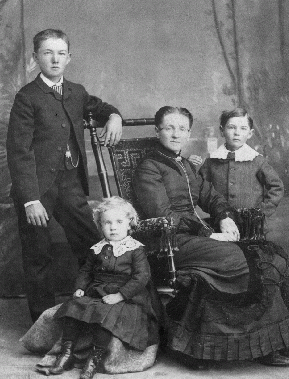 |
| Kittie with sons Lamoni, Alma, and Thomas |
The history notes:
“She celebrated her 17th birthday walking across the plains. Her twin sister, Mary Hobbs, drew the line when it came to picking up buffalo chips to burn, but not Caroline. She was such a jovial, happy girl and willing to do her share with the rest. Her work in the Relief Society was of the truest and best. Those days the Sunday eggs had to be gathered for tithing. Carpet rags sewn for the Temple and sox and shirts made for the men working on the Temple.
“Sister Watterson was one of the outstanding singers in Logan. She never had much confidence in herself and didn’t see why she was chosen as [Relief Society] President. Very few have such a wonderful disposition. She could join in and enjoy any kind of game with anyone. I remember just a few years before she died we were at Meyricks to a surprise party and Sister Watterson came costumed and what fun she had getting us all down on the floor for a game, then to tell us she didn’t know any game.”
William Watterson died June 6, 1920, in Logan. Kittie followed November 4, 1928, also in Logan.
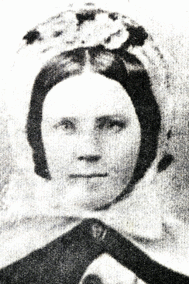 |
 |
| Mary Ann Hobbs Dunkley | Joseph Dunkley |
Soon after arriving in Franklin in 1864, Kittie’s twin, Mary Ann, went to live with the family of Joseph and Margaret Dunkley. By the end of the year she became Joseph’s plural wife. They were sealed in the Endowment House on November 12, 1864. Joseph was born August 6, 1824, in Stratford, Essex, a son of Benjamin Dunkley and Sarah Briggs. On April 17, 1866, while Joseph was on guard duty on the Little Mountain, Mary Ann went into labor and died of complications. The family felt the midwife was negligent, though by now it is impossible to know. The baby lived and was named Margaret Mary Ann Dunkley (Maggie). When Maggie grew up, the Church was encouraging Kittie’s husband to take another wife. Margaret loved a boy named Christian Lewis Hansen, but Aunt Kittie talked her into marrying William, so on September 19, 1884, she became Kittie’s sister wife. Lewis was so crushed he left to drive a stage in Yellowstone. William later served time in the Utah State Penitentiary for polygamy and paid a fine. Maggie and William had one son named Moses. Maggie pined for Lewis and cried every day, and finally she and William agreed to divorce. One day she came home and found Lewis on her porch. They married and had eight children. William gave Maggie a piece of land in Benson, which she “scar marked” for Moses’s mission. When he grew up he served in his father’s ancestral home on the Isle of Man.
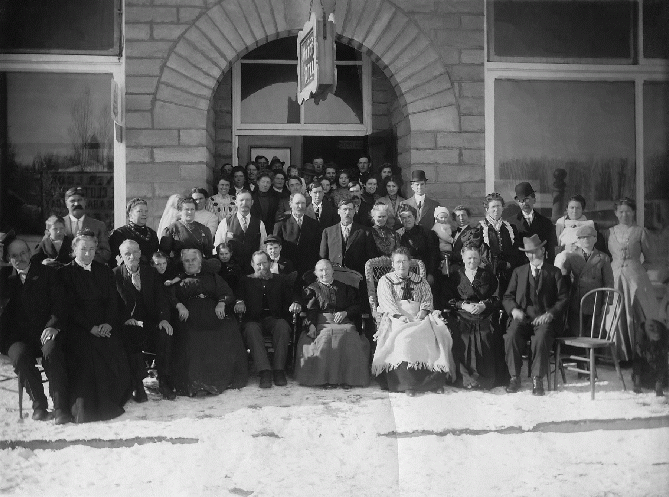 |
| Hobbs family reunion in 1911 Front, l-r: James, Martha, William, Matilda, Charles, Mary Ann, Edith Hadlock, Kitty, William Watterson |
Sources
First Generation
Second Generation
Background
I filled out the pioneer information from various sources, especially William Lindsey, Autobiography, in Mormon Immigration Index and LDS Archives, other Immigration Index histories, and LeRoy R. and Ann W. Hafen, Handcarts to Zion: The Story of a Unique Western Migration, 1856–1860 (1960). B. R. Parkinson’s story of Polly’s courtship comes via Preston W. Parkinson, The Family of Samuel Rose Parkinson, 147. Dates for Henry Hobbs’s mission can be found in the Millennial Star, vol. 19 no. 4 (24 Jan. 1857), 56; no. 51 (19 Dec. 1857), 811; vol. 21 no. 4 (22 Jan. 1859), 62–63; also the diary of James Lovett Bunting, part of the Overland Trails project on the BYU library home page. Henry’s home mission assignment we have from a letter to his missionary companion, reprinted in Lee D. Bell, South Weber: The Autobiography of One Utah Community (1990), 486. I took details of Franklin’s settlement from The Trail Blazer: History of the Development of Southeastern Idaho (Daughters of the Pioneers, 1930, 1976). The dates and numbers of children for each of the Hobbs siblings are from the Ancestral File and Pedigree Resource File—there may be errors in my totals.